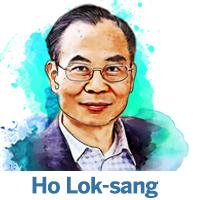It is ironic that events unfolding in China and the United States are showing the world that the two countries are going in opposite directions, in ways that defy previous stereotypes.
 Two central themes of the two sessions in Beijing are: risk containment and restoring confidence, and enhancing the well-being of the Chinese people. The former includes strengthening national security, reinvigorating the economy through fiscal and monetary tools, containing risks in financial markets, and restoring confidence among investors and consumers. The latter includes such things as high-level opening-up, innovation and industrial upgrading, rural revitalization, and environmental and ecological protection.
Two central themes of the two sessions in Beijing are: risk containment and restoring confidence, and enhancing the well-being of the Chinese people. The former includes strengthening national security, reinvigorating the economy through fiscal and monetary tools, containing risks in financial markets, and restoring confidence among investors and consumers. The latter includes such things as high-level opening-up, innovation and industrial upgrading, rural revitalization, and environmental and ecological protection.
China is showing the world that it is committed to universal values and embracing the market. The 2008 Beijing Olympics slogan was “One World, One Dream”.
The China Culture.org website says that this “fully reflects the essence and the universal values of the Olympic spirit — unity, friendship, progress, harmony, participation and dream”. The “dream” herein of course includes justice, equality, peace, respect, prosperity, health, and sustainable development. The world had thought that the US would lead it to achieve progress on these fronts, given its role in World War II and given that the headquarters of the United Nations is housed in New York City. Who could have imagined that the US would withdraw from the World Health Organization and the United Nations Human Rights Council, and halt all funding for the United Nations Relief and Works Agency for Palestine Refugees, and the UN climate damage fund set up to help developing countries face possible disasters brought about by climate change?
A key legislative highlight of the 2025 two sessions is the proposed Private Economy Promotion Law to inspire business confidence. The proposed law ensures fair market participation for private and foreign enterprises, and promises a stable business environment that is predicated on fair play and no policy surprises. It also addresses such concerns as difficulty in accessing financing and difficulty of legal recourse when exigencies require.
It must be eye-opening to see that whereas in China, businesses can use their business sense to decide what to produce, where to sell, and where to source their supplies, the US is increasingly acting like a centrally planned economy that defies market dynamics. President Donald Trump’s main tool is tariffs and taxes. He thinks that by imposing tariffs on imports, businesses will be forced to relocate to the US and that would “make America great again”. A recent initiative of his administration is the proposal of a port charge on Chinese-built ships calling at US ports and charges on container cranes manufactured in China. Instead of giving credit to China for its hard work that enabled the accomplishment, Trump accuses China of achieving what it did through “unfair” subsidies. He said he will “create a new office of shipbuilding in the White House and offer special tax incentives to bring this industry home to America where it belongs”. Trump does not realize that comparative advantage cannot be founded on taxes and directives. China was able to do so well on many fronts because China has the infrastructure, the workers, the engineers, and particularly the will. Consider the plight of the Taiwan-based semiconductor maker TSMC, which has invested $65 billion in three Arizona factories. It has faced challenges like skilled labor shortages, supply chain gaps, and high regulatory costs. According to TSMC CEO Wei Che-chia, the project is taking twice as long as it would need in Taiwan. Trump announced on March 3 that TSMC will invest at least an additional $100 billion over the next few years to build state-of-the-art semiconductor manufacturing facilities in the US. TSMC is doing this because the US has threatened to impose 100 percent tariffs on chips imported from overseas.
The charge that China achieved its preeminent status in a range of industries from electric vehicles to ships to drones through “unfair subsidies” is entirely based on fantasy. If subsidies are the reason, the US could certainly have done far better. Any subsidies the Chinese government provides to business come at a cost. Given that the US dollar is the world’s principal currency for international payments, the US could easily become an industrial powerhouse through subsidies financed by printing money.
China has national five-year plans, and the current year is the last year of the 14th Five-Year Plan (2021-25). But China today is no longer a centrally planned economy. While the two sessions and China’s five-year plans deliver important messages to all people and stakeholders in the country, the visions and targets proposed are all entirely in line with the country’s comparative advantages or potential comparative advantages. The US will not sell advanced chips to China and wants to cut China off from “American technology”. This has forced China to fast develop its potential comparative advantage in the production of advanced chips. The US excluded China from participating in the International Space Station. This has forced China again to develop its own space station.
Thanks to its long cultural tradition, China has this “can-do” spirit. The two sessions in Beijing are telling the world that China will overcome all difficulties, meanwhile sticking to universal values and following economic laws.
The author is an adjunct research professor at Pan Sutong Shanghai-HK Economic Policy Research Institute and Economics Department, Lingnan University.
The views do not necessarily reflect those of China Daily.


